修辞学讲义2-2分析
- 格式:ppt
- 大小:815.50 KB
- 文档页数:21
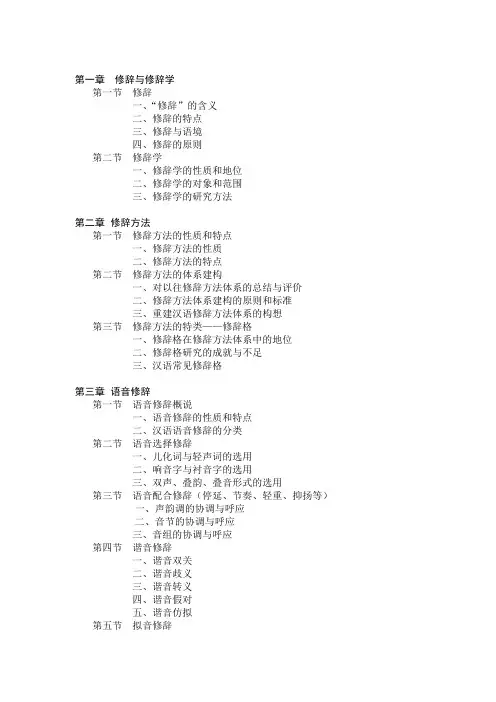
第一章修辞与修辞学第一节修辞一、“修辞”的含义二、修辞的特点三、修辞与语境四、修辞的原则第二节修辞学一、修辞学的性质和地位二、修辞学的对象和范围三、修辞学的研究方法第二章修辞方法第一节修辞方法的性质和特点一、修辞方法的性质二、修辞方法的特点第二节修辞方法的体系建构一、对以往修辞方法体系的总结与评价二、修辞方法体系建构的原则和标准三、重建汉语修辞方法体系的构想第三节修辞方法的特类——修辞格一、修辞格在修辞方法体系中的地位二、修辞格研究的成就与不足三、汉语常见修辞格第三章语音修辞第一节语音修辞概说一、语音修辞的性质和特点二、汉语语音修辞的分类第二节语音选择修辞一、儿化词与轻声词的选用二、响音字与衬音字的选用三、双声、叠韵、叠音形式的选用第三节语音配合修辞(停延、节奏、轻重、抑扬等)一、声韵调的协调与呼应二、音节的协调与呼应三、音组的协调与呼应第四节谐音修辞一、谐音双关二、谐音歧义三、谐音转义四、谐音假对五、谐音仿拟第五节拟音修辞一、拟声词其实是一种修辞词类二、汉语常见拟音修辞方法第四章语义修辞第一节语义修辞概说一、语义修辞的性质和特点二、汉语语义修辞的分类第二节同义修辞和反义修辞一、同义修辞二、反义修辞第三节上下义修辞和类义修辞一、上下义修辞二、类义修辞第四节多义修辞和单义修辞一、单义修辞二、多义修辞三、模糊修辞第五章语法修辞第一节语法修辞概说一、语法修辞的性质和特点二、汉语语法修辞的分类第二节词法修辞一、词类选择修辞二、词类活用修辞第三节句法修辞一、句法选择修辞二、句法配合修辞第四节篇法修辞一、形合谋篇与修辞二、意合谋篇与修辞第六章语形修辞第一节语形修辞概说一、语形修辞的性质和特点二、汉语语形修辞的分类第二节书面语形修辞一、汉字修辞二、非文字图符修辞第三节口语语形修辞一、态势语与修辞二、非语词声音与修辞三、伴随性因素与修辞第七章风格与修辞第一节言语风格与修辞一、言语风格的性质和分类二、言语风格的成因与修辞第二节语体风格与修辞一、语体的性质和分类二、语体修辞第八章汉语修辞学简史第一节汉语修辞学史及其研究概况一、修辞学史的性质二、汉语修辞学史的研究现状第二节汉语古代修辞学史说略一、汉语古代修辞学的演变轨迹二、汉语古代修辞学的演变规律第三节汉语现代修辞学史说略一、汉语现代修辞学的发展脉络二、汉语现代修辞学的发展规律第一章修辞第一节“修辞”的含义(一)修辞的三种含义1、语言运用活动(修辞行为)2、语言策略和技巧(修辞方法)3、研究语言运用规律的一门学科(修辞学)(二)“修辞”溯源1、出处目前所见最早的修、辞连用:“子曰:君子进德修业。


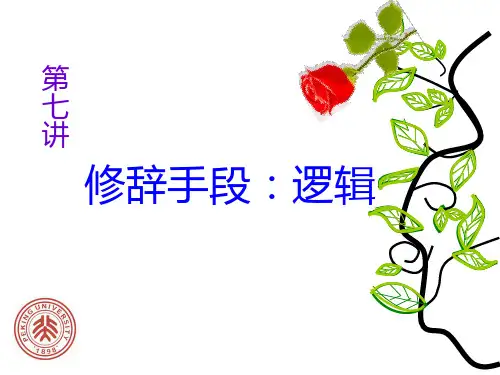

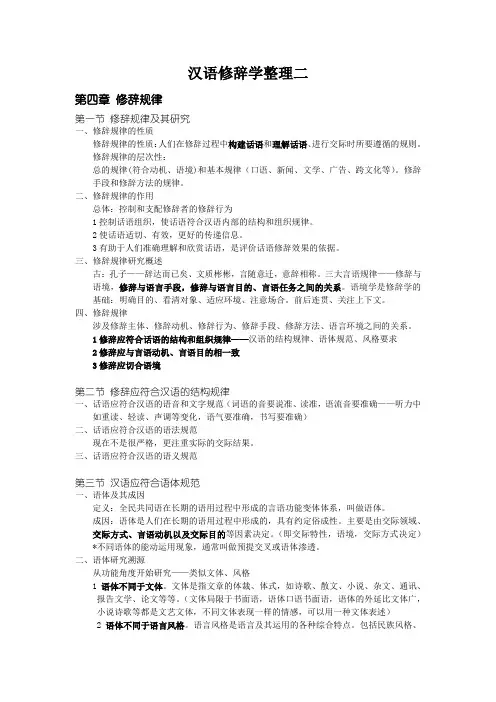
汉语修辞学整理二第四章修辞规律第一节修辞规律及其研究一、修辞规律的性质修辞规律的性质:人们在修辞过程中构建话语和理解话语、进行交际时所要遵循的规则。
修辞规律的层次性:总的规律(符合动机、语境)和基本规律(口语、新闻、文学、广告、跨文化等)。
修辞手段和修辞方法的规律。
二、修辞规律的作用总体:控制和支配修辞者的修辞行为1控制话语组织,使话语符合汉语内部的结构和组织规律。
2使话语适切、有效,更好的传递信息。
3有助于人们准确理解和欣赏话语,是评价话语修辞效果的依据。
三、修辞规律研究概述古:孔子——辞达而已矣、文质彬彬,言随意迁,意辞相称。
三大言语规律——修辞与语境,修辞与语言手段,修辞与语言目的、言语任务之间的关系。
语境学是修辞学的基础:明确目的、看清对象、适应环境、注意场合。
前后连贯、关注上下文。
四、修辞规律涉及修辞主体、修辞动机、修辞行为、修辞手段、修辞方法、语言环境之间的关系。
1修辞应符合话语的结构和组织规律——汉语的结构规律、语体规范、风格要求2修辞应与言语动机、言语目的相一致3修辞应切合语境第二节修辞应符合汉语的结构规律一、话语应符合汉语的语音和文字规范(词语的音要说准、读准,语流音要准确——听力中如重读、轻读、声调等变化,语气要准确,书写要准确)二、话语应符合汉语的语法规范现在不是很严格,更注重实际的交际结果。
三、话语应符合汉语的语义规范第三节汉语应符合语体规范一、语体及其成因定义:全民共同语在长期的语用过程中形成的言语功能变体体系,叫做语体。
成因:语体是人们在长期的语用过程中形成的,具有约定俗成性。
主要是由交际领域、交际方式、言语动机以及交际目的等因素决定。
(即交际特性,语境,交际方式决定)*不同语体的能动运用现象,通常叫做预提交叉或语体渗透。
二、语体研究溯源从功能角度开始研究——类似文体、风格1语体不同于文体。
文体是指文章的体裁、体式,如诗歌、散文、小说、杂文、通讯、报告文学、论文等等。


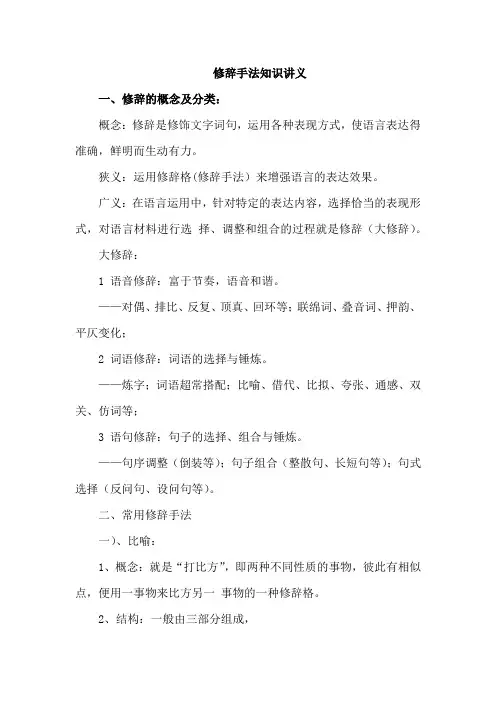
修辞手法知识讲义一、修辞的概念及分类:概念:修辞是修饰文字词句,运用各种表现方式,使语言表达得准确,鲜明而生动有力。
狭义:运用修辞格(修辞手法)来增强语言的表达效果。
广义:在语言运用中,针对特定的表达内容,选择恰当的表现形式,对语言材料进行选择、调整和组合的过程就是修辞(大修辞)。
大修辞:1 语音修辞:富于节奏,语音和谐。
——对偶、排比、反复、顶真、回环等;联绵词、叠音词、押韵、平仄变化;2 词语修辞:词语的选择与锤炼。
——炼字;词语超常搭配;比喻、借代、比拟、夸张、通感、双关、仿词等;3 语句修辞:句子的选择、组合与锤炼。
——句序调整(倒装等);句子组合(整散句、长短句等);句式选择(反问句、设问句等)。
二、常用修辞手法一)、比喻:1、概念:就是“打比方”,即两种不同性质的事物,彼此有相似点,便用一事物来比方另一事物的一种修辞格。
2、结构:一般由三部分组成,即本体(被比喻的事物)喻体(作比喻的事物)比喻词(比喻关系的标志性词语)3、构成比喻必须具备的条件:(一)甲和乙必须是本质不同的事物,否则不能构成比喻。
一个句子是不是比喻,不能单看有没有喻词,下列几处情况,虽有喻词,但不是比喻。
①同类相比。
例如:他长得很像他哥哥。
②表示猜度。
例如:他刚才好像出去了。
③表示想象。
例如:每当看到这条红领中,我就仿佛置身于天真灿漫的少年时节。
④表示举例的引词。
例如:本次考试很多同学的进步很大,像张昊、李疏桐等等。
(二)甲乙之间必须有相似点。
4、种类:(1)明喻:本体、喻体都出现,中间用比喻词“像、好像、似、仿佛、犹如、如”等联结。
例如:叶子出水很高,像亭亭的舞女的裙。
(2)暗喻:本体、喻体都出现,中间可用比喻词“是、成了、变成、化作、当作”等联结,有时不用比喻词。
例如:更多的时候,乌云四合,层峦叠蟑。
(3)借喻:本体、比喻词不出现,喻体出现。
例如:忽如一夜春风来,千树万树梨花开。
比喻的种类:明喻暗喻借喻<1>明喻(甲象乙) 例:共产党象太阳。
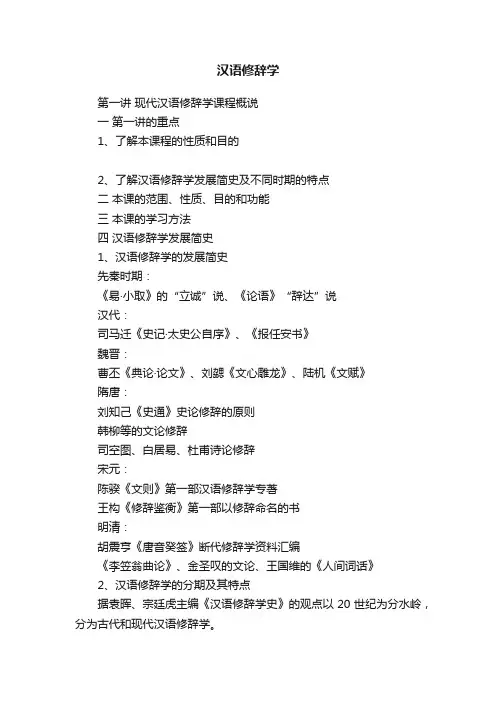
汉语修辞学第一讲现代汉语修辞学课程概说一第一讲的重点1、了解本课程的性质和目的2、了解汉语修辞学发展简史及不同时期的特点二本课的范围、性质、目的和功能三本课的学习方法四汉语修辞学发展简史1、汉语修辞学的发展简史先秦时期:《易·小取》的“立诚”说、《论语》“辞达”说汉代:司马迁《史记·太史公自序》、《报任安书》魏晋:曹丕《典论·论文》、刘勰《文心雕龙》、陆机《文赋》隋唐:刘知己《史通》史论修辞的原则韩柳等的文论修辞司空图、白居易、杜甫诗论修辞宋元:陈骙《文则》第一部汉语修辞学专著王构《修辞鉴衡》第一部以修辞命名的书明清:胡震亨《唐音癸签》断代修辞学资料汇编《李笠翁曲论》、金圣叹的文论、王国维的《人间词话》2、汉语修辞学的分期及其特点据袁晖、宗廷虎主编《汉语修辞学史》的观点以20世纪为分水岭,分为古代和现代汉语修辞学。
古代汉语修辞学内容丰富,但分散于经解、文论等论著中,未形成独立学科,缺少整体性、系统性。
现代汉语修辞学吸收西方修辞学理论又基础传统修辞学的基础,具有科学性、体系性、系统性特点。
第二讲修辞学概说一、第二讲的重点1、“修辞”的不同含义2、修辞学的研究对象和性质二、“修辞”的含义“修辞”可以指修辞学、修辞现象、修辞活动所谓修辞现象就是修辞活动所产生的“痕迹”。
它表现为高度的一致性。
古代的活用、今天的活用,古代的诗歌音乐美、今天的诗歌音乐美都有内部一致性,都是为了追求特殊修辞效果而进行一定修辞活动之后所留下的有明显规律性、系统性的可观察、分析的现象。
所谓修辞活动就是为追求一定的修辞效果而利用语言材料所进行的言语交际行为。
三、修辞学及其研究对象修辞学是研究言语交际行为过程中影响表达及接受效果的规律的学科。
修辞学探讨的是隐藏于修辞现象、修辞活动背后的具有普遍意义的成规模的体现出一定系统性的抽象又客观存在的规律。
修辞学的研究对象:与语言材料的运用有关的有一定交际目的的具体修辞活动、修辞现象背后的规律。

修辞学讲义
一、修辞学
修辞学是一门研究语言传达信息的艺术形式的学科。
它既研究传达信息的形式,也研究传达过程中的文学手段。
修辞学是一种关于文学艺术手法的研究,它可以提高作者表达的效率,加强语言的表现力,通过传达深刻的意义,使文学更加有力。
修辞学不仅仅详细分析文学手法,还对文学手法的使用进行探索,加强文学手法的表现力,从而达到文学作品艺术性的最大化。
二、主要分析内容
1、修辞方式:
(1)比喻:说明被比喻内容的相似性,形象化地表达深刻的意义,把深奥难解的事物阐释得清晰易懂,以令人印象深刻的方式展现信息。
(2)对比:对两个对象和事物进行对比,使得比较的对象更加突出,从而表达深刻的意义和独特的思考。
(3)讽刺与嘲讽:通过讽刺和嘲讽表达,引起读者的思考,从而深化其理解,但是要小心使用,以免加重作品艺术性。
(4)拟喻:通过比较,将高大与光明象征性的对象拟合堆叠用语,表达理解,谱写出风格高雅、抒情优美的文学作品。
(5)重复:展示思想的完整性,強化作者的意图。
2、修辞技巧
(1)游戏性:主要功能是扩大作品丰富性,营造新颖多样的文学性和视觉性效果,增强作品艺术性。
(2)押韵:押韵能够处理句子对称,增强句子表达效果,凸显作者的美感。
(3)通假字:用两个通假字开头或者结尾,明确思想目标,使句子更加紧凑和有力度。
(4)引用:引用外部文本赋予作品更多信息,提升幽默感和韵味,增加作品的阅读价值。
(5)修辞特点:有表达修辞,富于形象和艺术感,传达深刻的意义,使得作品的文学性更加丰富,思想更加丰富,现实意义更强烈。
三、修辞学的重要性
修辞学关注的是文字的传达,它是文字的艺术,。
Chapter Two Communicative(Passive) RhetoricThree levels of rhetorical operationRhetoric involves choice of words, sentence patterns, figures of speech, organization of paragraphs and composition. This process can be broken into three basic levels: Level One: words and phrasesLevel Two: sentence varietyLevel Three: organizing paragraphs into a complete textChoice of Words●Using suitable wordsCharacteristic of English vocabulary: include over a half-million words, and thousands of new ones are added every year.Principles of choosing words: To communicate our ideas precisely and effectively, we should choose the right words that are exact, fresh, vivid, and appropriate.◆Choose the most appropriate words:✧Mother Teresa is notorious for her work with the poor and sick in India.✧Because he did not know either party, the arbitrator was able to take an uninterestedview of the dispute.✧The businessperson has upheld a reputation for deception and deceit.◆Be aware of the audience or readers and suit to the occasion:✧Jack's house was destroyed by fire. Jim went to comfort him and asked him tocontact the insurance company. "Cheer up, my friend," he said, "your insuranceclaim will be proceeding like a house on a fire, I'm sure."●Denotation and connotationDefinitions◆Denotation is the specific, direct, and literal meaning of a word, as described in adictionary definition. It is also called denotative meaning or explicit meaning.✧ A man was killed and his son was seriously injured in an automobile accident. Theboy was rushed to a hospital. The surgeon took one look at him and said, "This ismy son! I can't operate on him!"◆Connotation is the associative or suggestive meaning of a word. It often implies attitudes,emotions, etc. of the speaker or writer, and is also called implicit meaning.✧"Proverb" would be the appropriate word to use in reference to saying from theBible.✧"Saw" is often used in reference to the wisdom handed down to us anonymously.✧"Epigram" is often used in reference to a witty statement.Words may have positive and negative connotations✧She has a slender figure.✧She looked thin after her illness.✧The child has skinny, freckled legs with prominent knees.✧The old horse was bony.Words have historical and social connotations✧It may yet compound the misery of Iraq in the same way Watergate followedVietnam.✧The old man is in the twilight of his career.Words have personal and general connotations✧Mother, home, peace, liberty✧Miser, radical, reactionary●General words and specific wordsDefinitions: general words refer to a group or class; specific words refer to a member of that class.✧Eiseley wrote about people prominent in science.✧Eiseley wrote about Darwin, Einstein and Franklin.✧They were specially concerned with astronomy.✧They were specially concerned with the solar system.2) Proprieties in writing or speaking specifically or generally The specific words tend togive color and tang, tend to appeal to the imagination. General words often used for thesake of diplomacy. Good writing or speaking has both general and specific information.✧He saw a ship/liner/ brig/ bark/ tank/ cargo steamer on the horizon.✧Some employees have been tying up the office phones with personal call.3) Approaches to write or speak in a specific way:◆Choosing words that bring about specific instead of vague ideas✧She uses simplicity in her style of writing.✧She writes with plain words and simple sentence patterns.✧The new expressway will shorten the journey between the two cities a great deal.✧The new expressway will shorten the journey between the two cities by 30 percent.◆Listing specific details✧Near the water there was a big tree that was rather impressive.✧On the edge of the pond, at the far side, there was an enormous walnut tree(胡桃树),standing like an open umbrella whose ribs(枝干)extended halfway across thestill water of the pool.◆Using illustrative examples✧In this century, the president is much more cut off from contact with the peoplethan in earlier times. Ordinary citizens, for example, could get to see AbrahamLincoln directly in the White House and make their requests to him in person.●Abstract words and concrete wordsDefinitions: A concrete word has an object as its referent, while an◆abstract word,a concept. For example, peach, pear, apple and apricot are concrete words.Sweetness, fuzziness and softness are abstract words because they refer to certainqualities or certain concepts or ideas.◆Relationship between abstract/ concrete words and general/specific words:Abstract words and general words usually do not overlap. But this is not the case with concrete words and specific words. Words that refer to particular objects and particular actions are usually both concrete or specific.◆Both abstract/general words and concrete/specific words have their own advantages:●Long words and short words1) From a stylistic point of view, words that are often used may be divided into threetypes: formal, common, and colloquial words. Long words often refer to the formalwords and some common words, while short words often refer to colloquial words andsome common words.✧(1)a. If you wish to cash a cheque, please let us know well before youleave.✧ b. In order to substantiate our desire to accommodate our guests,we would appreciate your co-operation in anticipating your creditrequirements before your departure.Formal words also called learned words or big words mainly appear in formal writing, such as scholarly or theoretical writing, political and legal documents, and formallectures. Most of formal words are of Greek, Latin or French origin. Except for specialpurpose formal words are seldom used in daily conversation. So, we must useappropriate words according to the formality of the situation.✧According to a Native American myth, the Great Creator had dog hanging aroundwith him when he created the earth.✧ b. According to a Native American myth, the Great Creator was accompanied by adog when he created the earth.✧I've gotta be in court at nine on Tuesday morning. For sure I won't be back in timefor Walker's bio test. Hope the old guy lets me take a makeup.✧Excuse me, sir. I have to be in court next Tuesday and so I have to be absent fromthe biology test. Would it be possible for me to take it at some later time?I Questions1. What is the relationship between denotation and connotation? Give examples to prove that words have denotative and connotative meanings.2. What are the rhetorical functions of general words and specific words in our writing and speaking. Show examples to support your point.3. What are the rhetorical functions of abstract words and concrete words in our writing and speaking? Show examples to support your point.II Choose the correct word(s) to complete each sentence.I. The _________( preceding / proceeding ) message was brought to us by General Motors.2. He says he would write an English course book if he could find a(n)______ _( accomplice/ collaborator ) to deal with the 1ess interesting parts.3. The whole audience was ______( affected/infected ) by her sad story and many burst into tears.4. If you put too many potatoes in that bag, it will ( burst /crack ),5. For many years, Mark has been suffering from the (delusion / illusion) that he is a great man.6. I cannot _________( tolerate/suffer) any more of your nonsense.1. Changing from solid to liquid, water takes in heat from all substances near it, and this _______ (transition/absorption) produces artificial cold surrounding it.8, I didn't say anything like that at all. You are purposely ____( revising/ distorting) my ideas to prove your point.9. I ( acknowledge /express ) with thanks the help of my colleagues in the preparation of this new column.My uncle went to the police station to (claim/ demand) the lost watch.。
第一讲记叙文阅读——修辞手法【知识梳理】一、修辞手法通过修饰、调整语句,运用特定的表达形式以提高语言表达效果的方式或方法。
二、复习(1)比喻①定义:用某些有类似特点的事物来比拟想要说的某一事物。
②结构:本体(被比喻的事物)、喻词(表示比喻关系的词语)、喻体(打比方的事物)。
③分类:A.明喻:本体、喻词和喻体同时出现。
常用的喻词有:像、好像、好似、如、有如、如同、恰似、仿佛……例子:他(本体)动也不动,彷如(喻词)石像(喻体)。
B.暗喻:本体、喻体同时出现,但用“是”“成”“成为”“变为”等系词代替“像”一类的喻词。
例子:母亲啊!你(本体)是荷叶(喻体),我(本体)是红莲(喻体)。
C.借喻:借喻是比喻中的高级形式,运用它时要求本体与喻体的关系十分密切,所以在特定的语境中,由喻体就可以直接领会到本体。
例子:世界的东方站着一个雄狮(喻体)。
④作用:_______________________________________________________________________ _______________________________________________________________________________(2)拟人①定义:把事物人格化,将本来不具备人动作和感情的事物变成和人一样具有动作和感情的样子。
②作用:_______________________________________________________________________ _______________________________________________________________________________(3)夸张①定义:运用丰富的想象力,在客观现实的基础上有目的地放大或缩小事物的形象特征,以增强表达效果的修辞手法。
②分类:A.扩大夸张:故意把客观事物说得“大、多、高、强、深……”的夸张形式。
汉语修辞学整理2汉语修辞学整理二第四章修辞规律第一节修辞规律及其研究一、修辞规律的性质修辞规律的性质:人们在修辞过程中构建话语和理解话语、进行交际时所要遵循的规则。
修辞规律的层次性:总的规律(符合动机、语境)和基本规律(口语、新闻、文学、广告、跨文化等)。
修辞手段和修辞方法的规律。
二、修辞规律的作用总体:控制和支配修辞者的修辞行为1控制话语组织,使话语符合汉语内部的结构和组织规律。
2使话语适切、有效,更好的传递信息。
3有助于人们准确理解和欣赏话语,是评价话语修辞效果的依据。
三、修辞规律研究概述古:孔子——辞达而已矣、文质彬彬,言随意迁,意辞相称。
三大言语规律——修辞与语境,修辞与语言手段,修辞与语言目的、言语任务之间的关系。
语境学是修辞学的基础:明确目的、看清对象、适应环境、注意场合。
前后连贯、关注上下文。
四、修辞规律涉及修辞主体、修辞动机、修辞行为、修辞手段、修辞方法、语言环境之间的关系。
1修辞应符合话语的结构和组织规律——汉语的结构规律、语体规范、风格要求2修辞应与言语动机、言语目的相一致3修辞应切合语境第二节修辞应符合汉语的结构规律一、话语应符合汉语的语音和文字规范(词语的音要说准、读准,语流音要准确——听力中如重读、轻读、声调等变化,语气要准确,书写要准确)二、话语应符合汉语的语法规范现在不是很严格,更注重实际的交际结果。
三、话语应符合汉语的语义规范第三节汉语应符合语体规范一、语体及其成因定义:全民共同语在长期的语用过程中形成的言语功能变体体系,叫做语体。
成因:语体是人们在长期的语用过程中形成的,具有约定俗成性。
主要是由交际领域、交际方式、言语动机以及交际目的等因素决定。
(即交际特性,语境,交际方式决定)*不同语体的能动运用现象,通常叫做预提交叉或语体渗透。
二、语体研究溯源从功能角度开始研究——类似文体、风格1语体不同于文体。
文体是指文章的体裁、体式,如诗歌、散文、小说、杂文、通讯、报告文学、论文等等。